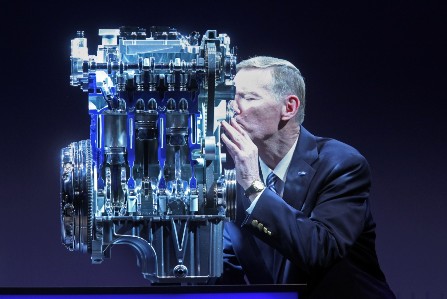You may have noticed the general downsizing trend that’s going on under the hood. V-8s gave way to sixxes – and sixxes, to fours.
Now, it’s down to three.
For the first time since the ’90s, you can buy several new cars with three cylinder engines. These include the 2014 Ford Fiesta (reviewed here) as well as the just-updated BMW Mini Cooper.
More are on deck, too.
This “displacement downsizing” is trending for the same reasons now as then: Less engine equals fewer parts equals lower cost and less weight. And of course, the big one. Fuel economy. A three-cylinder engine has one less piston pumping – and sucking – than a four cylinder engine.
It burns less gas.
But, it also makes less power … all else being equal.
A circa early ’90s-era Geo Metro’s 1 liter, three-cylinder engine delivered exceptionally high fuel economy: 38 MPG city – better than most current economy cars manage on the highway. And on the highway, the little Metro rated 45 MPG – a figure that has yet to be surpassed by any new car that’s not a hybrid or a diesel.
Very impressive – especially in view of the fact that the Metro did not have the technological advantages – such as CVT transmissions and direct/port fuel-injection – that are now commonly available.
However, the Metro was also almost unimaginably slow by current standards. It took 3-4 seconds longer to reach 60 MPH in a Metro than it does in the very slowest new car you can buy (which would be a Toyota Prius C hybrid; it takes about 12 seconds to get to 60). And while the Metro was capable of eventually reaching highway speeds, it often struggled to maintain them. At 75 MPH, the poor thing was very close to the edge of its performance envelope – and letting you know it with ever-increasing urgency. Dismal sounds of struggle emanated from under the hood. Flooring the accelerator did not result in acceleration. Just more cacophony of mechanical agony.
This was inevitable given the Metro’s 49 hp, 1.0 liter engine. (For some perspective, most current motorcycles have engines that are larger – and produce a lot more than than 49 hp.) It’s also unacceptable today. Back in the early ’90s, the highway speed limit was still 55 MPH, so traffic generally flowed no faster than the low sixties.
Speed limits today are commonly 65-70. And traffic flows closer to 75-80.
To make a modern three cylinder engine viable in today’s driving environment – where a car must be capable of getting to 60 in under 15 seconds and be able to maintain 70-75 MPH on the highway without threatening to spit parts out of the oil pan – turbochargers have been fitted to provide an on-demand displacement (and so, power) increase without the “always-on” fuel-inefficiency of a physically larger engine.
A turbo pressurizes the incoming air/fuel charge – stuffing each cylinder with more air/fuel than would otherwise be in there – temporarily (while under boost) increasing the effective displacement (and thus, power output) of the engine. This is why the current Ford Fiesta’s 1.0 liter engine produces 123 hp – more than twice as much power as the same-size Geo Metro’s 1 liter engine. But the take-home point is that the Fiesta’s power is on-demand. It only comes online when you ask for it – by pressing down on the accelerator. Which spools up the turbo, which – temporarily – increases the engine’s effective displacement and output.
If you’re not doing depressing the accelerator, on the other hand, the displacement remains small – and so does your gas bill.
It’s a win-win. Power – when you need it. High fuel efficiency the rest of the time.
But there are downsides. One actual, the other possible:
* Cost to buy –
Unlike the ’90s-era Geo, the new “turbo triples” are fairly pricey. A new (2014) Ford Fiesta’s base price is $14,100 – with the standard four-cylinder engine. To get the more fuel-efficient “EcoBoost” turbocharged three-cylinder engine, you have to go up one trim (to the SE, base price $15,585) and then buy the $995 “Ecoboost” package.
So, the base price of the Fiesta triple is $16,580.
This is inexpensive by current standards, relative to the cost of the typical new car. But it’s pricey compared to what an early ’90s Geo Metro cost. The base price of a ’91 Metro was just $6,750. Adjusted for inflation (see here) that’s under $12k in 2014 dollars.
* Cost down the road –
Adding a turbo and its related hardware (including a specialized exhaust system) adds an additional system to the car’s powertrain – which means the potential for more to go wrong, simply by dint of their being more things that could go wrong. It doesn’t mean they will. But they could.
This is the intangible – the unknowable.
As always in life, there’s no such thing as a free lunch.
But today’s triples are as close to having your cake – and eating it, too – as you’re likely to find.
If you’ve enjoyed what you’ve found here, please support EPautos.com. We depend on you, the readers, to keep the wheels turning.
Our donate button is here.
If you prefer to avoid PayPal, our mailing address is:
EPautos
721 Hummingbird Lane SE
Copper Hill, VA 24079












OK, so when do you think that TWO cylinder engines will start popping up? Especially in hybrid cars, where all the gasoline engine does is power a generator?
PS: Subaru’s “boxer” engines have their own wonderfully unique sound too…it took getting used to for me, though.
Hi Bryce,
Soon, I hope!
Twins are (usually) naturally balanced and very compact, among other desirable attributes. No reason a “twin” would not work well in a light-weight car.
Of course, that’s the trouble. Government has made it very hard for anyone to (legally) build a truly light-weight car….
Return of the Morgan!!
Bryce,
They already have TWO cylinder cars.
One of my favorites: The Citroën 2CV 😉
(Ok, just kidding. I am sure you meant a return of 2 cylinder engines for modern automobiles. It was just an excuse to point to the 2CV)
Bryce,
The Loremo was a 2-cyl engine car that unfortunately never made it to market.
It is a nice concept. Low weight and aerodynamic design auto that does not need a large engine to move vehicle and occupants.
Dang, and the only reason I got online tonight was to tell you guys about how it was cool to hear someone in the distance as they TWISTED the throttle and shifted through the gears while I polished the nickel plated center draft lamp in the garage tonight.
…The things make for excellent heaters. … But I’ve noticed, there’s been a serious decline in the number of motorcycles I hear at night. I’ve mentioned it before, but it seems even moreso lately… I wonder, do youth have so little money they cannot even buy Bikes? …The insurance requirement Has Got to be killing them. …. I wonder, is owning a bike the same to today’s youth as owning a car? They Just Can’t Do It, and,… they don’t want to?
if so, that’s so sad.
Riding free is so real. … No wonder TPTB wanna cut it off.
Hi Helot,
From what I gather, insurance on motorcycles is beyond ridiculous. A 25-year-old with a sport bike might be looking at $2k a year… on a bike that cost $10k. This is comparable to paying $4k a year to drive a car – and no doubt has put the kibosh on many young riders’ plans.
Now, insurance was also high in my day (’80s and ’90s) but – FEAFEFH – you could just ignore their got-damned laws and mostly/usually get away with it.
Not anymore.
Have never driven a three banger. But an odd number of cylinders make for inherently unbalanced harmonics. So I don’t doubt it sounds “unique…….” but “wonderfully” unique…..not buying. 😉 Not that this is a problem other than aesthetically.
Still, if this someday becomes the only realistic option to mass transit, I would buy one for sure.
Odd number of cylinders is not “inherently” unbalanced – only if not properly designed. With the right crank, one cylinder firing every 120 degrees is well balanced.
Now the old Buick V-6, where they just chopped 2 cylinders off a V-8 and still had a 90 Degree firing cycle – that could be rough. Once they reengineered the crank it was much better.
Hi Mike,
Modern three cylinder car engines are balanced in various ways such that you’d never be able to tell they’re not fours by feel. Or, sound.
Now, a two-stroke triple bike engine you can tell by sound…. from about two miles way!
Great article. I remember my 92 Ford Festiva getting 37mph on the highway. Then the gas guzzler era came about and gas efficient cars fell to the waste side until 10yrs ago. Funny how trends follow a circular path.
One upcoming vehicle to keep an eye on is the Elio Motors car (three wheeler). It’s going to sport An inline, 3 cylinder, .9 liter, 55 HP, fuel-injected, SOHC gas-powered, liquid-cooled, automotive engine manufactured in St Louis. Elio Motors boasts the car will get 49mpg city and 84mpg highway. 0-60 in 9.6 seconds. All at a cost of $6800!
I remember when I was in college back in the ’60s that there was a girl there driving a Saab. (the 544 Volvo was the ‘popular’ car at the time) I never saw under the hood, but I heard that it was a 3-cylinder 2-stroke. I do know that it smoked too much to survive the EPA.
Two stroke triples have a wonderfully unique sound – nothing else like it!